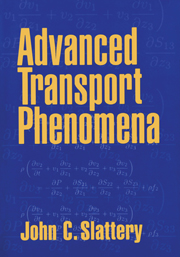Book contents
- Frontmatter
- Contents
- Preface
- List of Notation
- Advanced Transport Phenomena
- 1 Kinematics
- 2 Foundations for Momentum Transfer
- 3 Differential Balances in Momentum Transfer
- 4 Integral Averaging in Momentum Transfer
- 5 Foundations for Energy Transfer
- 6 Differential Balances in Energy Transfer
- 7 Integral Averaging in Energy Transfer
- 8 Foundations for Mass Transfer
- 9 Differential Balances in Mass Transfer
- 10 Integral Averaging in Mass Transfer
- A Tensor Analysis
- B More on the Transport Theorem
- References
- Author/Editor Index
- Index
1 - Kinematics
Published online by Cambridge University Press: 05 June 2012
- Frontmatter
- Contents
- Preface
- List of Notation
- Advanced Transport Phenomena
- 1 Kinematics
- 2 Foundations for Momentum Transfer
- 3 Differential Balances in Momentum Transfer
- 4 Integral Averaging in Momentum Transfer
- 5 Foundations for Energy Transfer
- 6 Differential Balances in Energy Transfer
- 7 Integral Averaging in Energy Transfer
- 8 Foundations for Mass Transfer
- 9 Differential Balances in Mass Transfer
- 10 Integral Averaging in Mass Transfer
- A Tensor Analysis
- B More on the Transport Theorem
- References
- Author/Editor Index
- Index
Summary
This entire chapter is introductory in much the same way as Appendix A is. In Appendix A, I introduce the mathematical language that I shall be using in describing physical problems. In this chapter, I indicate some of the details involved in representing from the continuum point of view the motions and deformations of real materials. This chapter is important not only for the definitions introduced, but also for the viewpoint taken in some of the developments. For example, the various forms of the transport theorem will be used repeatedly throughout the text in developing differential equations and integral balances from our basic postulates.
Perhaps the most difficult point for a beginner is to properly distinguish between the continuum model for real materials and the particulate or molecular model. We can all agree that the most factually detailed picture of real materials requires that they be represented in terms of atoms and molecules. In this picture, mass is distributed discontinuously throughout space; mass is associated with the protons, neutrons, electrons,…, which are separated by relatively large voids. In the continuum model for materials, mass is distributed continuously through space, with the exception of surfaces of discontinuity, which represent phase interfaces or shock waves.
The continuum model is less realistic than the particulate model but far simpler. For many purposes, the detailed accuracy of the particulate model is unnecessary. To our sight and touch, mass appears to be continuously distributed throughout the water that we drink and the air that we breathe. The problem is analogous to a study of traffic patterns on an expressway. The speed and spacings of the automobiles are important, but we probably should not worry about whether the automobiles have four, six, or eight cylinders.
- Type
- Chapter
- Information
- Advanced Transport Phenomena , pp. 1 - 27Publisher: Cambridge University PressPrint publication year: 1999



